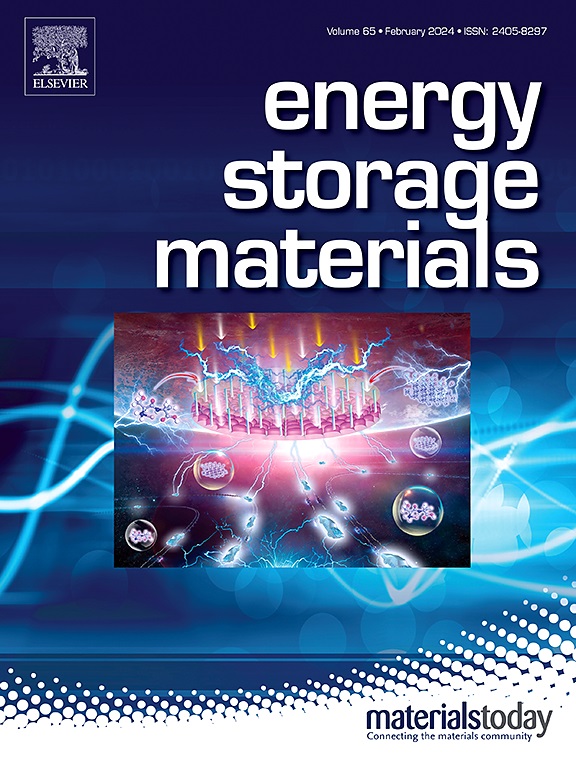低温圆柱形钠离子电池中电极膨胀、电解液耗竭和死钠的定量解耦
IF 20.2
1区 材料科学
Q1 CHEMISTRY, PHYSICAL
引用次数: 0
摘要
钠离子电池(SIBs)在低温(LT)储能方面表现出良好的潜力,但其在低温条件下的容量衰减机制仍未得到充分研究。在此,我们报道了全电池-电极-材料/界面的耦合机制,并定量分析了100% SOC nacacufemno2 ||硬碳圆柱形SIBs在-20℃长时间储存期间的电极膨胀、电解质损耗和死钠。基于多模态原位/非原位表征方法,我们发现了一种新的容量衰减机制,即以电解质耗竭和电荷转移极化为主的可逆容量损失(1-3个月),过渡到由界面恶化和死钠积累引起的不可逆容量损失(3个月)。有趣的是,我们定量分析了阳极电极在不同位置(内部、中心和外部区域)的膨胀率和死钠含量的变化,揭示了前所未有的异质降解模式:阳极电极降解主导了系统失效,与中心和外部区域相比,内部区域具有更高的膨胀和更大的死钠积累。因此,在低温条件下优化电池性能需要在电池设计过程中仔细优化涂层参数、绕组结构和电解质填充体积。本文章由计算机程序翻译,如有差异,请以英文原文为准。
Quantitative Decoupling of Electrode Expansion, Electrolyte Depletion, and Dead Sodium in Low-Temperature Storage Cylindrical Sodium-Ion Cell
Sodium-ion batteries (SIBs) exhibit promising potential for low temperature (LT) energy storage, yet their capacity decay mechanisms under LT conditions remain insufficiently investigated. Herein, we report the coupled mechanisms of Full cell - Electrode - Material/Interface, and quantitative analysis of electrode expansion, electrolyte depletion, and dead sodium of 100% SOC NaCuFeMnO2 || Hard Carbon cylindrical SIBs during prolonged storage at -20 ℃. Based on multimodal in situ/ex situ characterization methodologies, we found a new capacity fade mechanism of LT storage, which reversible capacity loss (1-3 months) dominated by electrolyte depletion and charge transfer polarization, transitioning to irreversible capacity loss caused by interface deterioration and dead sodium accumulation (>3 months). Interestingly, we quantitatively analyzed the changes in the expansion rate and dead sodium content of the anode electrode at different positions (inner, center, and outer region) and revealed unprecedented heterogeneous degradation patterns: anode electrode degradation dominates system failure, inner region and exhibit higher expansion and greater dead sodium accumulation compared to center and outer regions. Consequently, optimizing cell performance under LT conditions necessitates careful optimization of coating parameters, winding architectures, and electrolyte filling volumes during cell design.
求助全文
通过发布文献求助,成功后即可免费获取论文全文。
去求助
来源期刊

Energy Storage Materials
Materials Science-General Materials Science
CiteScore
33.00
自引率
5.90%
发文量
652
审稿时长
27 days
期刊介绍:
Energy Storage Materials is a global interdisciplinary journal dedicated to sharing scientific and technological advancements in materials and devices for advanced energy storage and related energy conversion, such as in metal-O2 batteries. The journal features comprehensive research articles, including full papers and short communications, as well as authoritative feature articles and reviews by leading experts in the field.
Energy Storage Materials covers a wide range of topics, including the synthesis, fabrication, structure, properties, performance, and technological applications of energy storage materials. Additionally, the journal explores strategies, policies, and developments in the field of energy storage materials and devices for sustainable energy.
Published papers are selected based on their scientific and technological significance, their ability to provide valuable new knowledge, and their relevance to the international research community.
 求助内容:
求助内容: 应助结果提醒方式:
应助结果提醒方式:


